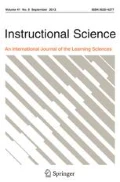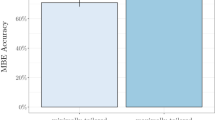Abstract
In most mathematics textbooks, each set of practice problems is comprised almost entirely of problems corresponding to the immediately previous lesson. By contrast, in a small number of textbooks, the practice problems are systematically shuffled so that each practice set includes a variety of problems drawn from many previous lessons. The standard and shuffled formats differ in two critical ways, and each was the focus of an experiment reported here. In Experiment 1, college students learned to solve one kind of problem, and subsequent practice problems were either massed in a single session (as in the standard format) or spaced across multiple sessions (as in the shuffled format). When tested 1 week later, performance was much greater after spaced practice. In Experiment 2, students first learned to solve multiple types of problems, and practice problems were either blocked by type (as in the standard format) or randomly mixed (as in the shuffled format). When tested 1 week later, performance was vastly superior after mixed practice. Thus, the results of both experiments favored the shuffled format over the standard format.




Similar content being viewed by others
References
Bahrick, H. P., Bahrick, L. E., Bahrick, A. S., & Bahrick, P. E. (1993). Maintenance of foreign-language vocabulary and the spacing effect. Psychological Science, 4, 316–321.
Bjork, R. A. (1979). Information-processing analysis of college teaching. Educational Psychologist, 14, 15–23.
Bjork, R. A. (1988). Retrieval practice and the maintenance of knowledge. In M.M. Gruneberg, P.E., Morris, & R.N. Sykes (Eds.), Practical aspects of memory II (pp. 391–401). London: Wiley.
Bjork, R. A. (1994). Memory and meta-memory considerations in the training of human beings. In J. Metcalfe & A. Shimamura (Eds.), Metacognition: Knowing about knowing (pp. 185–205). Cambridge: MIT.
Bloom, K. C., & Shuell, T. J. (1981). Effects of massed and distributed practice on the learning and retention of second-language vocabulary. Journal of Educational Research, 74, 245–248.
Carpenter, S. K., & DeLosh, E. L. (2005). Application of the testing and the spacing effects to name learning. Applied Cognitive Psychology, 19, 619–636.
Carson, L. M., & Wiegand, R. L. (1979). Motor schema formation and retention in young children: A test of Schmidt’s schema theory. Journal of Motor Behavior, 11, 247–251.
Cepeda, N. J., Pashler, H., Vul, E., Wixted, J. T., & Rohrer, D. (2006). Distributed practice in verbal recall tasks: A review and quantitative synthesis. Psychological Bulletin, 132, 354–380.
Christina, R. W., Bjork, R. A. (1991). Optimizing long-term retention and transfer. In D. Druckman & R. A. Bjork (Eds.), In the mind’s eye: Enhancing human performance (pp. 23–56). Washington DC: National Academy Press.
Dempster, F. N. (1989). Spacing effects and their implications for theory and practice. Educational Psychology Review, 1, 309–330.
Driskell, J. E., Willis, R. P., & Copper, C. (1992). Effect of overlearning on retention. Journal of Applied Psychology, 77, 615–622.
Fitts, P. M. (1965). Factors in complex skill training. In R. Glaser (Ed.), Training research and education (pp. 177–197). New York: Wiley.
Foriska, T. J. (1993). What every educator should know about learning. Schools in the Middle, 3, 39–44.
Gilbert, T. F. (1957). Overlearning and the retention of meaningful prose. Journal of General Psychology, 56, 281–289.
Glencoe (2001) Mathematics: Applications and Connections—Course 1. New York: Glencoe-McGraw Hill.
Grote, M. G. (1995). Distributed versus massed practice in high school physics. School Science and Mathematics, 95, 97–101.
Hall, J. F. (1989). Learning and memory, 2nd Ed. Boston: Allyn & Bacon.
Jahnke, J.C., & Nowaczyk, R. H. (1998). Cognition. Upper Saddle River: Prentice Hall.
Kester, L., Kirschner, P. A., & Van Merriënboer, J. J. G. (2004). Timing of information presentation in learning statistics. Instructional Science, 32, 233–252.
Krueger, W. C. F. (1929). The effect of overlearning on retention. Journal of Experimental Psychology, 12, 71–78.
Mayfield, K. H., & Chase, P. N. (2002). The effects of cumulative practice on mathematics problem solving. Journal of Applied Behavior Analysis, 35, 105–123.
Pashler, H., Rohrer, D., Cepeda, N. J., & Carpenter, S. K. (2007). Enhancing learning and retarding forgetting: Choices and consequences. Psychonomic Bulletin & Review (in press).
Postman, L. (1962). Retention as a function of degree of overlearning. Science, 135, 666–667.
Radvasky, G. (2006). Human memory. Boston: Pearson Education Group.
Rea, C. P., & Modigliani, V. (1985). The effect of expanded versus massed practice on the retention of multiplication facts and spelling lists. Human Learning: Journal of Practical Research & Applications, 4, 11–18.
Reynolds, J. H., & Glaser, R. (1964). Effects of repetition and spaced review upon retention of a complex learning task. Journal of Educational Psychology, 55, 297–308.
Rittle-Johnson, B. & Alibali, M. W. (1999). Conceptual and procedural knowledge of mathematics: Does one lead to the other? Journal of Educational Psychology, 91, 175–189.
Rittle-Johnson, B., Siegler, R. S., & Alibali, M. W. (2001). Developing conceptual understanding and procedural skill in mathematics: An iterative process. Journal of Educational Psychology, 93, 346–362.
Rohrer, D., & Taylor, K. (2006). The effects of overlearning and distributed practice on the retention of mathematics knowledge. Applied Cognitive Psychology, 20, 1209–1224.
Rohrer, D., & Taylor, K. (2006). The effects of overlearning and distributed practice on the retention of mathematics knowledge. Applied Cognitive Psychology, 20, 1209–1224.
Saxon, J. (1997). Algebra I (3rd Ed.). Norman: Saxon Publishers.
Schmidt, R. A., & Bjork, R. A. (1992). New conceptualizations of practice: Common principles in three paradigms suggest new concepts for training. Psychological Science, 3, 207–217.
Smith, S. M., & Rothkopf, E. Z. (1984). Contextual enrichment and distribution of practice in the classroom. Cognition and Instruction, 1, 341–358.
VanderStoep, S. W., & Seifert, C. M. (1993). Learning ‘how’ versus learning ‘when’: Improving transfer of problem-solving principles. Journal of the Learning Sciences. 3, 93–111.
Acknowledgments
This research was supported by a grant from the Institute of Education Sciences, US Department of Education. We thank Kristina Martinez and Erica Porch for their assistance with data collection.
Author information
Authors and Affiliations
Corresponding author
Appendix
Appendix
Permutations
If a sequence of items includes n items and k unique items, the number of permutations of the sequence equals n!/(n 1! n 2! ... n k !), where n i equals the number of occurrences of item i. Thus, for the sequence abbccc, the number of permutations equals 6!/(1! 2! 3!), or 60.
Wedge
A wedge is obtained by the truncation of a cylinder by two planes if exactly one of the planes is perpendicular to the cylinder and if the linear intersection of the two planes includes exactly one point on the cylindrical surface. If the latter constraint is relaxed so that the linear intersection may intersect the cylindrical surface at either one or two points, the solid is a cylindrical wedge. This is the shape shown in Fig. 3a. We chose the term wedge for this specific case because we do not know of an accepted term. Its volume equals r 2 hπ/2, where r equals the radius of its circular base and h equals its maximum height
Spherical cone
A spherical cone is obtained by removing a conical section of a sphere provided that the vertex of the cone is at the sphere’s center and the base of the cone is on the sphere’s surface, as shown in Fig. 3a. Its volume is given by 2r 2 hπ/3, where r equals the radius of the sphere and h equals the difference of the sphere’s radius and the cone’s height
Spheroid
A spheroid is obtained by the rotation of an ellipse about one of its axes. The spheroid in Fig. 3a, for example, is rotated about its vertical axis. Its volume equals 4r 2 hπ/3, where r equals the “equatorial radius” and h equals the “polar radius.” The values of r and h also equal one-half of the major and minor lengths of the rotated ellipse.
Half cone
A half cone is a cone truncated by a plane parallel to its base so that the truncation reduces the cone’s height by half. Its volume equals 7r 2 hπ/3, where r equals the radius of the upper base and h equals the height of the truncated cone, as illustrated in Fig. 3a. The half cone is a specific instance of a conical frustum, which has a height equal to any proportion of the cone’s height. We chose the term “half cone” to describe a conical frustrum with height equal to exactly half of the cone’s height.
Rights and permissions
About this article
Cite this article
Rohrer, D., Taylor, K. The shuffling of mathematics problems improves learning. Instr Sci 35, 481–498 (2007). https://doi.org/10.1007/s11251-007-9015-8
Received:
Accepted:
Published:
Issue Date:
DOI: https://doi.org/10.1007/s11251-007-9015-8




